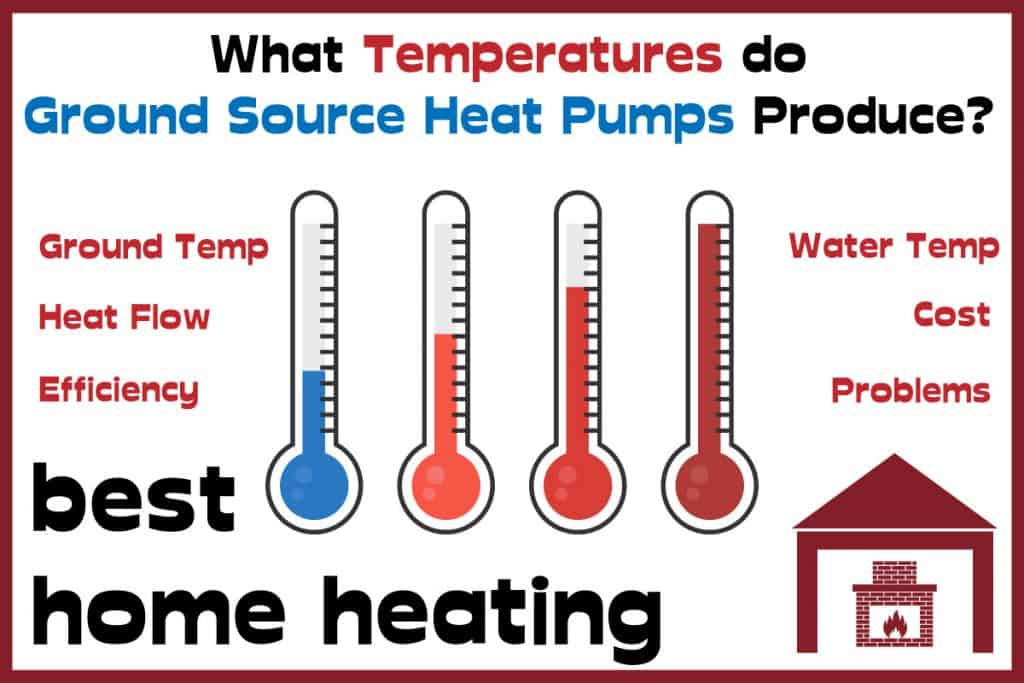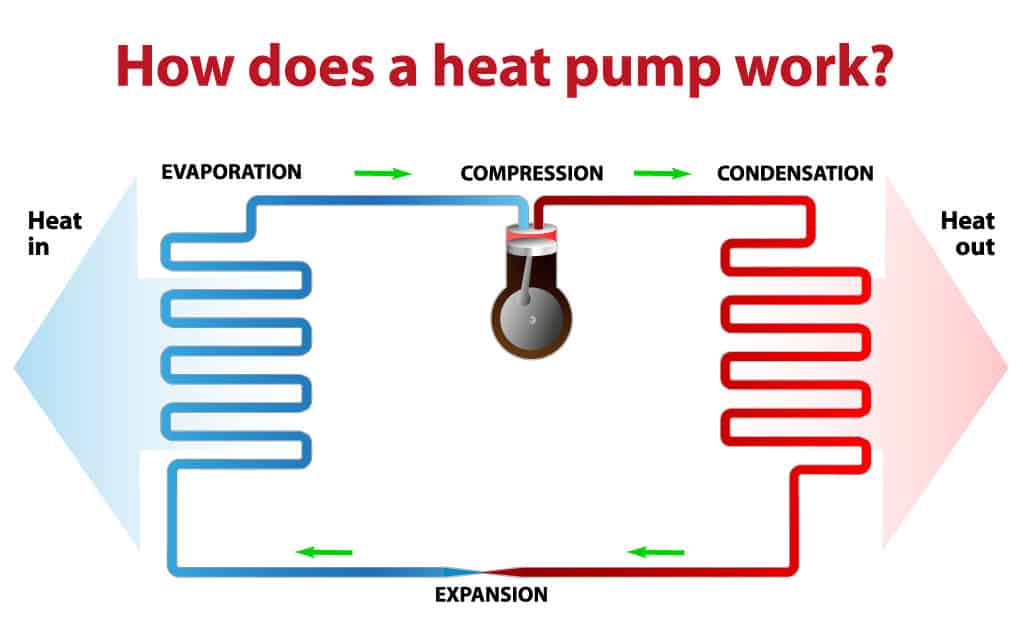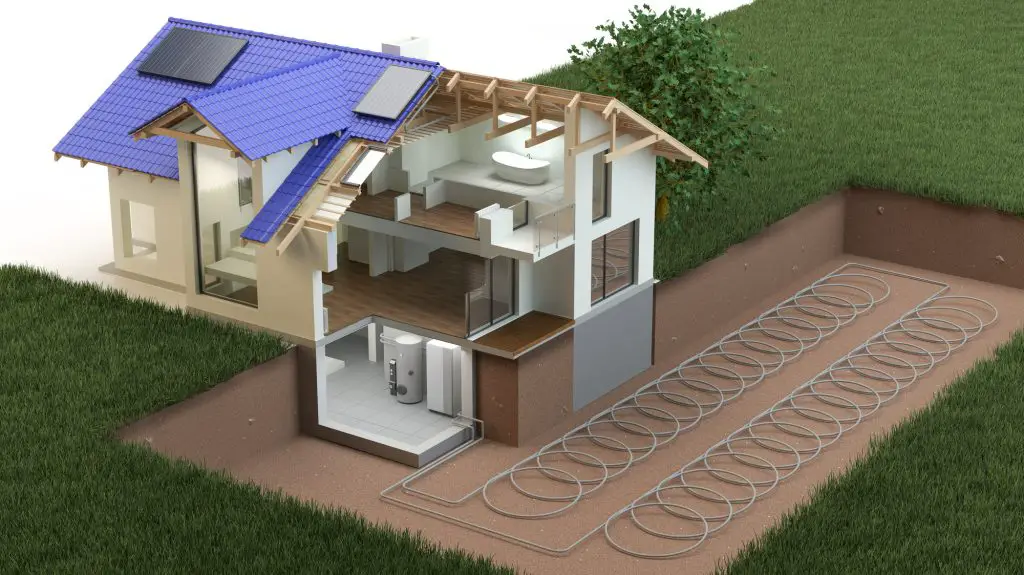Ground source heat pumps, also known as geothermal heat pumps, have emerged as an efficient and environmentally friendly alternative to traditional boilers. The system works by extracting natural heat from the ground and then amplifying the heat.
A ground source heat pump is a low-flow home heating system that works at significantly cooler temperatures than a boiler. The heat pump extracts heat from soil (10-16 degrees) and amplifies it to a water flow temperature of 25-30 degrees. Higher temperatures are possible at lower system efficiency.
In this post, we are going to shed light on the temperature basics of ground source heat pumps. Before we dive in, let’s see how the system works.

First, let’s see how a ground source heat pump works. How does the heat transfer from the ground to a radiator in the first place?
- A ground source heat pump takes advantage of the sun’s energy stored underground. Underground pipes, designed to allow heat transfer through their walls, are installed to access the ground’s constant temperature.
- The fluid running through the array of ground pipes is a mixture of water and antifreeze. This mixture absorbs the low-grade heat from the ground array as it circulates. Lots of heat energy can be absorbed this way due to the length and surface area of the pipes.
- On its return to the control hub, the water-antifreeze mixture enters a heat exchanger, also known as an evaporator. The heat exchanger has two sealed-off compartments, one housing the flowing water-antifreeze mixture, and another holding a volume of refrigerant. The two liquids never mix together.
- The heat energy in the water-antifreeze mixture, which has been absorbed from the ground, then diffuses through the pipes in the heat exchanger and into the refrigerant liquid, which then boils into a gas due to its very low boiling point. The water-antifreeze mixture continues to circulate back into the ground loops for another cycle.
- The gas is then fed into a compressor, which increases the pressure of the gas and hence its temperature. This hot gas then flows into a second heat exchanger, known as the condenser. This component is very similar to the evaporator heat exchanger which transferred the heat from the water-antifreeze mixture. However, this time it transfers heat from the refrigerant gas and into a flowing water circuit which can then go off to heat the home via radiators or underfloor heating, or perhaps heat the water supply to the taps.
- The refrigerant gas that has lost its heat then condenses back to a liquid as it cools beneath its boiling point. It then passes through an expansion valve, reducing the temperature and pressure and circulating back to the evaporator heat exchanger ready to meet more warmed water-antifreeze mix and to repeat the cycle.

You can learn more about how radiators combine with ground source heat pumps by watching this video from Kensa Heat Pumps on Youtube.
What Temperature Do Ground Source Heat Pumps Reach?
About 10 feet underneath your feet, the ground maintains a constant temperature of 5-14°C throughout the year. This ground temperature does not fluctuate depending on weather conditions.
The system extracts the heat from the ground and then amplifies it, raising the temperature from 5-14°C to 20-25°C. This temperature range is significantly lower than that of a traditional boiler, which operates at 60-70°C.
It is to be noted here that now there are high-temperature heat pumps designed to produce as much temperature as boilers. While high-temperature heat pumps are a remarkable addition to the technology, they have their disadvantages (more on them later).
Is hotter better with a ground source heat pump?
Due to its lower flow temperatures, a ground source heat pump is very effective when combined with underfloor heating. An underfloor heating system has a large surface area that requires a low-temperature flow.
To get the best out of this combination (i.e the highest energy efficiency), it’s important to keep the outlet temperature as low as possible. If the temperature of your underfloor heating is kept low, the heat pump does not have to overwork, and therefore works smoothly and lasts longer.

What is the maximum temperature achieved by a ground source heat pump?
The maximum temperature a ground source heat pump can achieve is 55°C. A GSHP is more efficient when it runs at low temperatures—around 35°C to 45°C.
However, there are ground source heat pumps with cutting-edge technology, such as the Vattenfall pump that can reach 60-80°C. Can these heat pumps replace traditional boilers? No, because a heat pump running at high temperatures consumes more electricity.
What factors affect the temperatures achieved by ground source heat pumps?
The efficiency of a geothermal heat pump depends on factors such as moisture, underground temperature, rocks, and soil type. That’s why it’s important to discuss your project with a professional before you dive in. The professional can assess the factors and let you know if a geothermal heat pump is a good option for you.
The first factor is the soil’s moisture content. If the soil is moist, your heat pump’s heat transfer rate will be higher. The drier the soil the lower the heat transfer rate.
Under the ground, temperatures do not fluctuate but are not the same in all places. This variation affects the efficiency of a ground source heat pump. Horizontal looping systems, which are shallow, resulting in low heat transfer rates. In contrast, vertical looping systems offer higher heat transfer rates.
Thermal transfer also depends on the type of soil. Rocky soil, as in a mountainous region, can decrease the efficiency of a ground source heat pump. If the soil is too rocky, drilling for looping pipes may not be possible. And in this case, an air source heat pump may be a better option for you.
Your heat pump’s efficiency also largely depends on the way you use it. If you frequently turn the system on and off, the system will use a lot of electricity every time it turns on.
Typically, a heat pump has 2-3 cycles per hour. And the system runs for 10-20 minutes during each cycle. When it’s extremely cold outside, feel free to keep the pump constantly running.

What temperature is too cold for a ground source heat pump?
A ground source heat pump has a remarkable advantage over an air source heat pump. The former has a steady coefficient of performance (COP), which means the ground maintains a constant temperature regardless of the weather conditions. This is why geothermal heat pumps are more suitable for cold temperatures.
The performance of a ground source heat pump remains the same even when temperatures drop to -30°C. That’s not the case with an air source heat pump; its performance decreases to some extent as the outdoor air temperatures drop.
A geothermal heat pump works very well even in below-freezing temperatures. If you are living in an extremely cold region, do not hesitate to get a geothermal heat pump installed. It has a reputation as the ultimate cold weather heat pump.

What temperatures are achieved with High-Temperature Ground Source Heat Pumps?
High-temperature heat pumps are known for their capability for achieving higher operating temperatures ranging from 60 to 80°C. The system achieves this feat by using a special compressor technology.
While it’s a remarkable addition to the standard heat pump technology, it’s mostly used for hot water production. This is because high-temperature ground source heat pumps are not as energy efficient as standard ones.
While a typical low-temperature geothermal heat pump produces 3 units of heat with 1 unit of electricity, a high-temperature system produces 2.5 units of heat for 1 unit of electricity. Increased installation cost is another reason why high-temperature systems have not yet gained much popularity.
Conclusion – Ground Source Heat Pump Temperatures – Key Points
Geothermal heat is one of the most energy-efficient technologies of home heating. Efficient compressors, large heat exchangers and variable speed compressors are the hallmarks of this technology.
Due to its low-temperature output, a ground source heat pump works very well with underfloor heating. The system is more efficient when it operates at low temperatures. And while there are high-temperature geothermal heat pumps, they use more electricity than standard ones, and therefore are less efficient.
Factors such as underground temperature, soil type and presence of rocks in the soil have effects on the performance of the system. But if the conditions are met, a geothermal heat pump definitely has an edge over a traditional boiler.
While the installation cost is a bit high, the system has low running costs, so it will pay back in the long run. If you are thinking of reducing your carbon footprint, replacing your boiler with a ground source heat pump is one of the best things you can do. If needed, you can even combine your ground source heat pump with a boiler.
One of the best things about a geothermal heat pump is that its COP remains steady, no matter how cold the outside temperature is. Even when it’s freezing outside, the system will not cease to work.
With that said, we encourage you to consult a provider and learn if a geothermal heat pump is the right choice for you. A reliable provider can walk you through the whole process.
